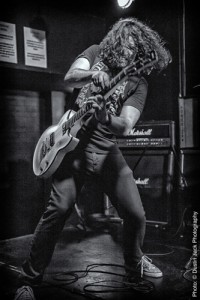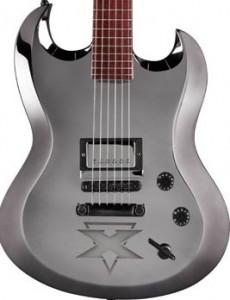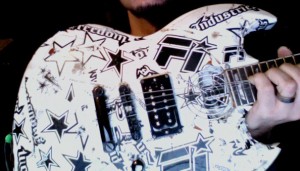Get “That” Guitar Tone: Phil X
Have you heard the story of how Phil Xenidis, better known as Phil X, went from painting garages to playing with Tommy Lee of Mötley Crüe to playing almost every guitar track on the first Daughtry album, to becoming the lead guitar player for Bon Jovi?
If yes, then you are probably not unfamiliar with Fretted Americana, a vintage guitar store in Calabasas, CA that exploded in popularity due to their collaborations with Phil in which he demos guitars for their YouTube channel.
A simple search of “Phil X” on YouTube yields almost 3 million results, and some of the most popular of these consist of Phil playing guitars for the Fretted Americana YouTube channel.
His ability to engage on video, thanks to his relentless and sometimes over-the-top energy is part of the reason this Canadian native is now one of the most popular session guitarists in L.A.—and something of a hero to countless young hard rock guitarists.
Today, we will look at some of the key gear Phil X uses, and even more importantly, break down some techniques on how to approach his massive guitar sounds in the studio.
Phil X’s Guitars
As a studio musician, Phil X plays a wide variety of guitars, amps, and pedals. He currently has a signature guitar line with Framus, as well as a signature Friedman Phil X guitar amplifier head. He has also been an artist with Yamaha Guitars and before that, ESP.
For those of us who can’t justify spending well more than $5,000 for a Phil X Signature guitar from Framus, some more affordable options are available for approximating these tones.
Yamaha Revstar RS820CR ($999)
Though Phil X is no longer a Yamaha artist, his signature Phil X SG1801PX is still a fantastic sounding guitar.
The new Revstar guitars, no longer branded with his name, are still amazingly well-built instruments that can coax the most pristine clean tones and with the flick of a distortion channel rip your face off. There are also less expensive guitars available in the Revstar line if you want big, fat guitar sounds on more of a budget.
ESP LTD Viper-256 ($399)
One of Phil X’s most used live guitars is his ESP Viper, which is covered with stickers.
The fretwork on this guitar is immaculate and the pickups are pretty good ones for this price range, though swapping in some Arcane pickups will get you much closer to Phil’s tones fast. It’s a relatively affordable guitar that’s built for rock and feels comfortable to play.
Amps
Friedman Phil X Signature 100 Watt Amp Head ($3199)
Phil X Evil Robot Custom 214 EVR C30 ($699)
Friedman Pink Taco 20 Watt Amp Head ($1499)
Effects
Line 6 M9 ($399)
Digitech Whammy 5 ($199)
Digitech Bad Monkey ($50)
Eventide H9 Standard ($499)
Strings & Picks
Phil digs into his guitars remarkably hard, and comes from the Dave Grohl school of playing the guitar like a drummer when it comes to picking velocity. Because he’s so aggressive on his strings, he has been using Cleartone coated strings with good results, and has adopted the Everly Star Picks, which have a star-shaped hole in the middle, making them easier to hold on to while picking hard.
Techniques:
1) Small Amps Can Yield Huge Sounds
Phil is well known for getting massive, thick guitar sounds, so it’s ironic that for a long time his “secret weapon” amplifier was a vintage Magnatone ToneMaster Custom 214. This small “accordion” combo amplifier is seen in many of the Fretted Americana videos that helped skyrocket Phil X to the status of YouTube guitar icon.
Phil also uses a Marshall MS-2 micro amp for practicing guitar and demonstrating guitar techniques. It’s hard to find guitarists who aren’t interested in this kind of amp (my own simple video demo of the MS-2 has been viewed over 135,000 times on YouTube) and you might be surprised by the huge sounds you can get by putting a SM57 right on one of these.
Small amps like these can also work well for getting some new and unusual textures if you want to double track or quadruple track the same guitar part, which leads us to our next tip:
2) Quintple Guitar Tracking: Quad Stereo Guitar Tracks with a Mono Fuzz Pedal DI
Do you double track guitars? Do you triple track guitars? Wait, Phil X quintuple tracks his guitars?? X has explained this method before, and if you want to get the massive distorted guitar “Wall of Sound” on your tracks, then you should try out this technique. Phil explains that he has quadruple tracked the same guitar part, panning two of the guitar tracks left and the other two right, then playing another fuzz pedal DI track and leaving it in mono.
Phil may have borrowed this trick from Led Zeppelin as he is a fan of Jimmy Page’s guitar skills and production techniques:
“Andy Johns used the mike amp of the mixing board to get distortion,” Page told Brad Tolinski about the recording of “Black Dog” for the book Light and Shade.
“Then we put two 1176 Universal compressors in a series on that sound and distorted the guitars as much as we could and then compressed them. Each riff was triple tracked—one left, one right, and one right up the middle. The solos were recorded in a more standard way. I wanted something that would cut through the direct guitars—I wanted a totally different tone color. So I ran my guitar through a Leslie and miked that in the usual way.”
3) Double Mic’ing: Dynamic Mic plus a Ribbon Mic
Phil has a great video on his YouTube channel where he demonstrates some techniques for speaker mic’ing in the studio. He uses both a Shure SM57 and a Royer R-121 mic on his guitar cab, as he feels it captures the full range of tones coming from his amp. The SM57 is a notoriously bright and sometimes harsh sounding microphone on guitar amps, but when blended with the warmth of the Royer ribbon microphone, you get a certain magic.
This technique is not unique to Phil and has been used on many recordings, but it is one of his own favorite approaches. If you don’t have these particular microphones, remember that you can also try using a “brighter” microphone and a “darker microphone” as substitutes. I’ve even had surprisingly good results substituting the Royer R-121 with a bass / kick drum focused microphone such as the AKG D112, Sennheiser e602, or the Shure Beta 52A.
4) Screw The Neck Pickup
If you are a fan of Phil X, you probably know of his ESP LTD “Sticker” guitar. This guitar has one solitary bridge pickup. X even went as far as to take the neck pickup out of the guitar and replaced it with a fan grille.
His philosophy is that if you are not using the neck pickup on your guitar, then you should take it out as the magnets in the pickup are constantly pulling on your guitar strings and will limit their ability to vibrate and resonate.
I have tried this on one of my guitars and while the results were not massive, friends who pick up this guitar tend to be surprised by how acoustically loud the instrument is without any amplification, and it may have something to do with this simple guitar mod. If you are going to change pickups on a guitar yourself, or if you never use the neck pickup on one of your guitars, try it out and see if you like it.
5) Bouzouki Tuning
Just as George Harrison and Keith Richards became fans of the Indian music and borrowed sitar ideas for their guitar playing, Phil has used Greek Bouzouki-inspired licks on many guitar tracks.
The Bouzouki is a Greek instrument that is similar to the mandolin in that it has 8 strings arranged in 4 pairs similar to a 12 string guitar. Check out the guitar intro to the song “Seat of my Pants” from Phil’s old band, Powder, if you want to hear this effect.
To achieve this distorted bouzouki-esque sound, detuning your high E string to a B and then lift this new, second B string out of its nut slot into the nut slot along with your regular B string nut slot. Tune it again so that they are the same pitch, and your guitar should be tuned from bottom to top, E A D G B B
From here, you can play a melody on both B strings and bend both so that one goes out of tune at a different rate than the other, giving you a sort of built-in chorus effect.
This trick is a lot of fun, and stands among many instances of great guitarists“borrowing” licks and idiosyncrasies of other instruments and applying them to the guitar. Much like Jimmy Page played the guitar with a violin bow, Dave Grohl hits the guitar and arranges his parts from the perspective of a drummer, and Albert Lee and Chet Atkins adapted banjo rolls to the six string, Bouzouki techniques are fair game and still ripe for exploration.
To see this technique in action, try this video and skip to the 6 minute mark:

There are so many factors that play a part in your guitar tone, and it’s the small details that you give attention to that will culminate in the unique character of your own sound.
To this end, Phil X is constantly practicing and experimenting with new recording techniques and ideas on how to make a guitar sound crazier and more interesting—but he is also able to do so in a way that is tasteful and appropriate for the sake of the record. Any guitarist or recordist can learn from that.
If you want to learn more about Phil X and what the life of a pro session musician is like, check out the documentary, HIRED GUN, which features Phil, Rudy Sarzo, Nita Strauss, Kenny Aronoff, and Alice Cooper, among others.
For some amp simulator settings for emulating Phil X’s tones, click here. And if you think there are any other Phil X tricks and tips we missed, tell us about them in the comments below!
Please note: When you buy products through links on this page, we may earn an affiliate commission.









